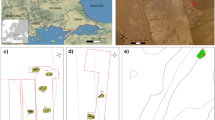Abstract
RECENT international efforts to conserve the African elephant Loxodonta africana prompted us to seek an appropriate method for determining the area from which individual tusks were derived. Trace element analysis of ivory has indicated the potential of chemical analysis for source identification1, but recent isotopic studies of African mammals2–5 suggest another approach. Stable carbon isotope ratios (13C/12C) in elephant bone collagen clearly reflect the mixture of C3 foliage and C>4 grasses in the diet, and are directly proportional to the density of C3 browse2. Furthermore, nitrogen isotope ratios (15N/14N) in bone collagen of African mammals are related to rainfall or water stress3–5. Strontium isotopes (87Sr/86Sr) in bone or ivory can be expected to reflect local geology6,7. Here we report on a study of ivory and bone samples from different regions of Africa demonstrating the feasibility of trivariate isotopic analysis to identify the area in which an elephant lived, thus providing a potentially powerful tool for the control of illegal trading in ivory.
This is a preview of subscription content, access via your institution
Access options
Subscribe to this journal
Receive 51 print issues and online access
$199.00 per year
only $3.90 per issue
Buy this article
- Purchase on Springer Link
- Instant access to full article PDF
Prices may be subject to local taxes which are calculated during checkout
Similar content being viewed by others
References
Bell, R. H. V., Kelsall, J. P., Rawluk, M. & Avery, D. H. Pachyderm 12, 29–31 (1989).
Van der Merwe, N. J., Lee-Thorp, J. A. & Bell, R. H. V. Afr. J. Ecol. 26, 163–172 (1988).
Heaton, T. H. E., Vogel, J. C., von la Chevallerie, G. & Collett, G. Nature 322, 823–824 (1986).
Ambrose, S. H. & DeNiro, M. J. Oecologia 69, 395–406 (1986).
Sealy, J. C., van der Merwe, N. J., Lee-Thorp, J. A. & Lanham, J. L. Geochim. cosmochim. Acta 51, 2707–2717 (1987).
Ericson, J. E. J. hum. Ecol. 14, 503–514 (1985).
Sealy, J. C. van der Merwe, N. J., Sillen, A., Kruger, F. J. & Krueger, H. W. J. archaeol. Sci. (in the press).
Lee-Thorp, J. A. PhD thesis, University of Cape Town (1989).
Vogel, J. C. S. Afr. J. Sci. 74, 298–301 (1978).
Van der Merwe, N. J. & Vogel, J. C. Nature 276, 815–816 (1978).
Vogel, J. C. Oecol. Pl. 13, 89–94 (1978).
Medina, E. & Minchen, P. Oecologia 45, 377–378 (1980).
Van der Merwe, N. J. & Medina, E. Geochim. cosmochim. Acta 53, 1091–1094 (1989).
Heaton, T. H. E. Oecologia 74, 236–246 (1987).
Sealy, J. C. Cambridge Monographs in African Archaeology 15, British Archaeological Reports International Series 293 (British Archaeological Reports, Oxford, 1986).
Author information
Authors and Affiliations
Additional information
National Parks Board, Private Bag X402, Skukuza 1350, South Africa
Rights and permissions
About this article
Cite this article
van der Merwe, N., Lee-Thorp, J., Thackeray, J. et al. Source-area determination of elephant ivory by isotopic analysis. Nature 346, 744–746 (1990). https://doi.org/10.1038/346744a0
Received:
Accepted:
Issue Date:
DOI: https://doi.org/10.1038/346744a0
This article is cited by
-
The association between haemosporidian infection and non-breeding moult location in great reed warblers revisited by combining feather stable isotope profiles and geolocator data
Oecologia (2023)
-
The deterrent effects of individual monoterpene odours on the dietary decisions of African elephants
Animal Cognition (2023)
-
Assessing laser ablation multi-collector inductively coupled plasma mass spectrometry as a tool to study archaeological and modern human mobility through strontium isotope analyses of tooth enamel
Archaeological and Anthropological Sciences (2022)
-
Diachronic forager mobility: untangling the Stone Age movement patterns at the sites Norje Sunnansund, Skateholm and Västerbjers through strontium isotope ratio analysis by laser ablation
Archaeological and Anthropological Sciences (2022)
-
Discrimination of highly degraded, aged Asian and African elephant ivory using denaturing gradient gel electrophoresis (DGGE)
International Journal of Legal Medicine (2021)
Comments
By submitting a comment you agree to abide by our Terms and Community Guidelines. If you find something abusive or that does not comply with our terms or guidelines please flag it as inappropriate.



